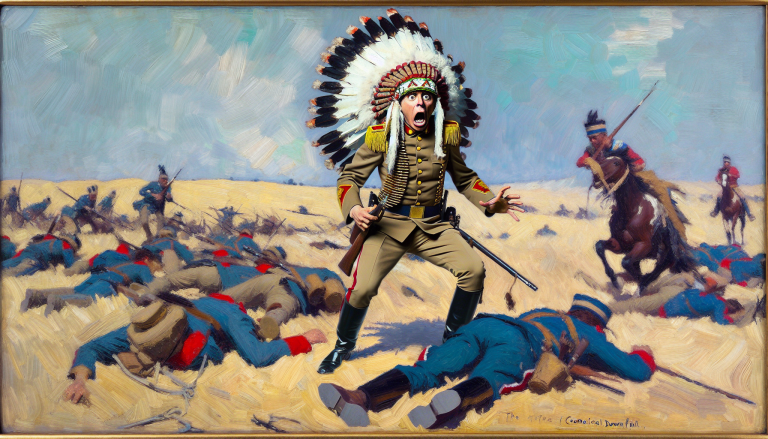Flogging a Deceased Equine: The Comical Misadventures of General Custer and the Battle of Little Bighorn
A Punchline in the Making: General Custer’s Doomed Campaign
History, often painted in the somber tones of war and conquest, can sometimes descend into the realm of pure farce. And nowhere is this more evident than in the case of General George Armstrong Custer and his disastrous encounter with Native American forces at the Battle of Little Bighorn. This fateful clash, which has become synonymous with the phrase “beating a dead horse,” stands as a testament to the perils of hubris, overconfidence, and the importance of heeding even the most obvious warning signs.
The year was 1876, and Custer, a decorated Civil War veteran, was riding high on a wave of success. Hailed as a dashing and fearless leader, he had earned a reputation for bold, if not reckless, tactics that had served him well in previous engagements. However, his unwavering belief in his own invincibility would soon lead him down a path of utter calamity.
Custer’s Folly: A Futile Effort to the Very End
Assigned to lead a contingent of the U.S. Army against a coalition of Native American tribes, including the Lakota, Cheyenne, and Arapaho, Custer was convinced that his troops would easily overwhelm the opposition. Despite repeated warnings from his fellow officers about the formidable nature of the enemy forces, the general remained steadfast in his belief that a swift and decisive victory was at hand.

As the battle unfolded, Custer’s overconfidence quickly turned to abject horror. His troops, outnumbered and outmaneuvered, found themselves surrounded and outmatched. The general’s disastrous decision to split his forces, in a vain attempt to encircle the enemy, only compounded the disaster, leading to the complete annihilation of his command.
“It was a classic case of ‘beating a dead horse,'” remarked one historian, “Custer simply refused to acknowledge the reality of the situation, even as his men were being cut down around him.”
Custer’s Legacy: A Cautionary Tale of Hubris and Folly
The Battle of Little Bighorn has since become a byword for futile endeavors, a cautionary tale of the dangers of unchecked ego and a refusal to accept the limitations of one’s own abilities. Custer’s stubborn insistence on pursuing a course of action that was doomed from the outset has been the subject of countless historical analyses, satirical articles, and even political cartoons.
One such cartoon, published in the aftermath of the battle, depicts Custer astride a skeletal horse, hacking away at its lifeless body with his sword, while his beleaguered troops look on in despair. The caption reads, “General Custer, still beating a dead horse, while his command is being wiped out.”
This enduring image encapsulates the essence of Custer’s undoing – a stubborn refusal to acknowledge the futility of his actions, even in the face of overwhelming evidence to the contrary. It is a testament to the enduring power of satire and humor to shed light on the foibles of the human condition, even in the most tragic of circumstances.
In the years since the Battle of Little Bighorn, the phrase “beating a dead horse” has become a staple of the English language, used to describe any situation where an individual or organization persists in a course of action that is clearly doomed to failure. From failed political campaigns to ill-conceived business ventures, the phrase serves as a stark reminder of the perils of hubris and the importance of embracing reality, no matter how unpalatable it may be.
Lessons Learned: The Enduring Legacy of Custer’s Blunder
As we reflect on the enduring legacy of the Battle of Little Bighorn, it becomes clear that Custer’s blunder holds valuable lessons for us all. It serves as a reminder that even the most decorated and celebrated leaders are not immune to the pitfalls of overconfidence and a refusal to adapt to changing circumstances.
Moreover, Custer’s story underscores the importance of heeding the advice of seasoned professionals and subject matter experts, even when their counsel may not align with our own preconceptions. Had the general listened to the warnings of his fellow officers, he might have avoided the catastrophic outcome that unfolded on that fateful day.
In the end, the Battle of Little Bighorn stands as a testament to the enduring power of satire and humor to illuminate the foibles of the human condition. Through the lens of this comical and tragic event, we are reminded that even the most grandiose of endeavors can be reduced to the futile act of “beating a dead horse” – a phrase that will continue to resonate for generations to come.
